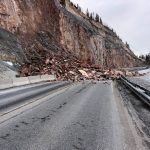Snowshoers killed on Hoosier Pass did not have avalanche transceivers
Pair was traveling in exposed terrain where avalanches are more common

Two snowshoers who were killed in an avalanche Saturday, Jan. 8, on Hoosier Pass have been identified as Hannah Nash, 25, and Drake Oversen, 35, of Colorado Springs, according to the Summit County coroner.
The pair died along with their dog, Valerie, after they were caught and buried in an avalanche they triggered while snowshoeing near North Star Mountain. The cause of death was listed as blunt force trauma and asphyxiation, according to the coroner.
The slide broke about 10 feet deep, 400 feet wide and ran about 250 vertical feet, according to the Colorado Avalanche Information Center’s preliminary report.
Summit County Rescue Group spokesperson Charles Pitman said the group received a report at around 10 a.m. Sunday, Jan. 9, that the couple didn’t show up to a planned get-together with friends in Colorado Springs, and that they had been snowshoeing around Crystal Lake.
Pitman said there are two Crystal Lakes in Summit County, and while a Summit County Sheriff’s Office deputy didn’t see any sign of the couple’s vehicle at the first trailhead, it was later found at the top of Hoosier Pass.
After finding the car, Pitman said the rescue group mission coordinator asked for Flight for Life to survey the area for anything that could indicate the couple was still out there. That’s when avalanche debris was discovered. Because of snow and wind the previous day and night, Pitman said there were no obvious tracks near the slide visible from the air, but it was clear the avalanche was large enough that it could be related to the missing pair.
At that point, the Colorado Rapid Avalanche Deployment program was asked to bring two search dog teams, which consist of a dog, a dog handler and a snow technician. It was one of these dogs that discovered Nash, Oversen and their dog buried in the avalanche debris.
Colorado Avalanche Information Center Director Ethan Greene said the couple did not have backcountry rescue equipment, including avalanche transceivers, which are devices that can help locate someone in the event of an avalanche.
“This is something that we all carry, and it’s extremely important,” Greene said about backcountry travel.
The pair represent the second and third avalanche deaths of this winter season and the first snowshoers killed in an avalanche since December 2014.
Greene said snowshoers don’t typically go into avalanche terrain as much as skiers, snowboarders and snowmobilers, who are looking for the steeper slopes.
“It’s not usual, but it’s not unique,” Greene said about the snowshoers being killed in an avalanche. “We have seen people that are involved in snowshoeing die in avalanches in the past.”
Pitman said he can’t recall another snowshoer death due to an avalanche in his time with Summit County Rescue Group.
“Snowshoers tend to do things that are relatively easy, and most of the time they are away from the danger, but unfortunately that wasn’t the case,” Pitman said about the Saturday incident.
Greene said he doesn’t know whether the couple who died was experienced in the backcountry, but he recommended a few ways to stay safe, including carrying the right gear and checking the avalanche forecast at Avalanche.State.co.us.
Greene added that a little bit of education can go a long way, especially for those looking to explore more high-risk terrain.
“Just like if you’re going to the beach or going to have a picnic, you want to know what the weather is going to be like, so you can prepare for that, you can decide where you actually want to go, what sort of equipment you want to bring,” Greene said. “The same is true with avalanche safety, so checking the forecast is the most important thing.”
Greene said the avalanche danger was rated considerable (3 out of 5) in the Summit County area on the day the snowshoers died, and the location where the avalanche occurred near North Star Mountain was exposed terrain where avalanches are more common. He said the area was a wind-loaded, near-treeline slope that also happened to be facing northeast, making it particularly high risk for an avalanche.
Pitman added that many folks think an avalanche can be triggered only from the top of a slope, but a slide can be triggered from the side or below.
“There are multiple ways that an avalanche can be triggered, and I think it’s really wise for people to look long and hard at Colorado Avalanche Information Center’s website and just what are the conditions and how are they setting up,” Pitman said. “That is a wealth of information that not every state has, and we’re fortunate to have one of the best.”
Greene said that over the next few days, investigators from the avalanche center will work to release a full report to explain as much as it can about the avalanche, which is part of the center’s mission to document human interactions with avalanches from a scientific, public safety and education perspective.

Support Local Journalism

Support Local Journalism
As a Summit Daily News reader, you make our work possible.
Summit Daily is embarking on a multiyear project to digitize its archives going back to 1989 and make them available to the public in partnership with the Colorado Historic Newspapers Collection. The full project is expected to cost about $165,000. All donations made in 2023 will go directly toward this project.
Every contribution, no matter the size, will make a difference.





